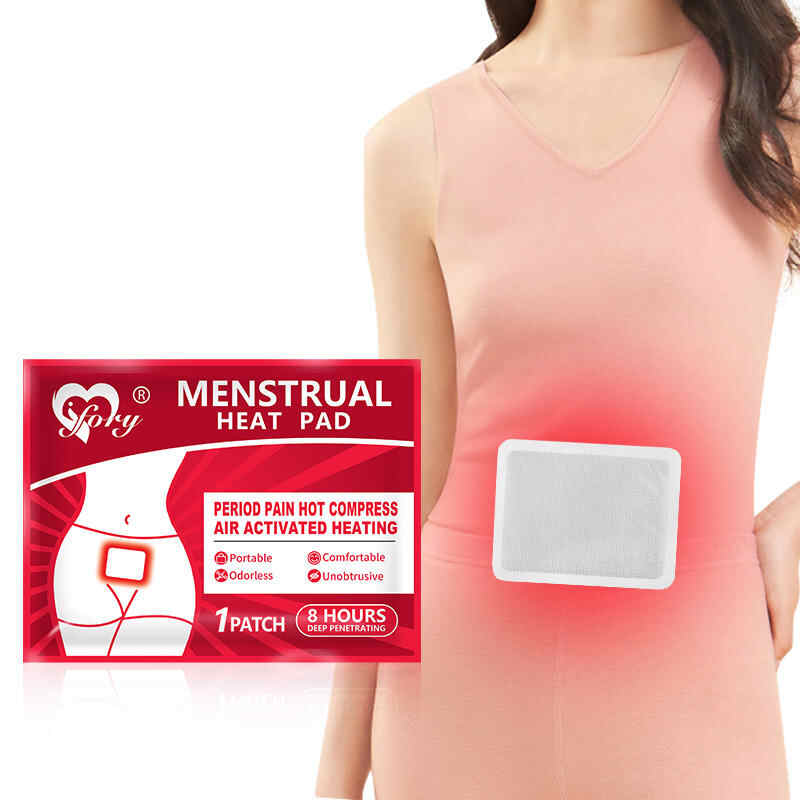Are Custom Menstrual Heating Pads More Expensive? — A Deep Dive into OEM, Private Label, and Supplier Costs
When brands in the menstrual wellness space consider launching a heating pad product, a central question often arises: “Are custom menstrual heating pads more expensive?” The short answer is: yes — custom versions typically command higher costs. But “expensive” is nuanced, and costs depend on many variables. In this article, we unpack the factors, compare models (custom vs. private label), and provide actionable insight for anyone evaluating partnerships with a Menstrual Heating Pad Manufacturer / OEM / Supplier.

1. Definitions and Key Concepts
Before digging into costs, it helps to define a few central terms — particularly in relation to your SEO and product strategy:
Menstrual Heating Pad Manufacturer / Supplier / OEM: A factory or company that designs and produces heating pads. “OEM” (original equipment manufacturer) often implies they handle manufacturing based on client specifications.
Custom Menstrual Heating Pad: A product designed uniquely for your brand — custom heating element, shape, temperature profiles, materials, packaging, and features.
Private Label Menstrual Heating Pad: A pre-developed or semi-standard product from a supplier; you only change branding, packaging, and minor tweaks.
Menstrual Heating Pad OEM / Private Label / Supplier: The same parties can act as both OEM and supplier; nature of service (custom vs. private label) is the differentiator.
In essence, Custom = from-scratch design, while Private Label = rebrand an existing base product. Many Menstrual Heating Pad OEMs / Suppliers offer both models. kongdymedical.com+1
2. Why Custom Menstrual Heating Pads Tend to Cost More
Custom products drive costs upward for several reasons. Below are the primary cost drivers and trade-offs:
| Cost Factor | Why It’s Higher for Custom | Impact / Example |
|---|---|---|
| R&D and Engineering | You are developing a new design or heating scheme, requiring engineering, prototyping, testing, iteration | Hiring thermal engineers, writing specifications, multiple rounds of samples |
| Tooling and Mold Costs | Custom shapes, enclosures, internal heating circuit boards may require custom molds | One-time mold or injection tool costs |
| Material Selection | You may demand premium or specialty materials (e.g. breathable fabrics, low-off-gassing adhesives, sensors) | Higher per-unit costs for advanced materials |
| Certification & Testing | New designs must be validated for safety, regulatory compliance (e.g. CE, IEC, UL, RoHS, EMC) | Lab testing, documentation, iteration |
| Lower Economies of Scale (Initial Volume) | Since your design is unique, volume is initially lower, so per-unit cost cannot benefit from mass scale | First batch cost is higher |
| Complexity & Features | More sensors, temperature zones, control electronics, battery, app connectivity all raise cost | Additional components, firmware, integration |
| Intellectual Property / Licensing | You may negotiate exclusive rights or patents, which raise supplier’s margin demands | Licensing or exclusivity premium |
Therefore, by nature, a Custom Menstrual Heating Pad places more burden on the manufacturer in design, quality control, and risk — which is passed on in pricing.
3. Cost Ranges: What OEM / Supplier Quotes Suggest
To ground theory in real-world data, let’s look at what actual Menstrual Heating Pad Manufacturers / Suppliers / OEMs are quoting publicly:
On one platform, standard menstrual heat pads (non-electronic, simpler adhesive versions) list around USD 3.68–5.29 per unit (wholesale) for relatively sophisticated models.
Some manufacturers in China advertise disposable heating patches for menstrual relief at as low as USD 0.14–0.49 / piece depending on scale and complexity.
An OEM offering “warm patch cartoon patch heating pad (customizable)” quotes USD 0.08–0.10 / piece at high volumes.
For more advanced belt-style rechargeable menstrual heating belts (wearable device), quotes from a factory as USD 3–5+ / piece (MOQ in the hundreds or thousands) are seen.
So, for a custom-designed, feature-loaded, wearable heating pad, it is not unusual to see costs multiple times higher than a simpler, off-the-shelf private label version.
4. Comparing Custom vs. Private Label Pricing and Risks
To decide whether custom is “worth it,” you must weigh cost against risk and benefit. Below is a comparative view:
| Aspect | Private Label | Custom |
|---|---|---|
| Development Cost | Low — you adopt existing product | High — you invest in design, prototyping |
| Lead Time | Shorter (because base product already exists) | Longer (design, testing, iteration) |
| Minimum Order Quantity (MOQ) | Often lower, more flexible | Typically higher to amortize development cost |
| Unit Price at Scale | Lower (established BOM and process) | Higher (custom parts, lack of volume initially) |
| Brand Differentiation | Moderate — only branding, packaging differ | High — product uniqueness, features, IP |
| Risk / Uncertainty | Lower — product already market-proven | Higher — possibility of design flaws, delays, certification fail |
| Upgrade Path | May hit ceiling on differentiation | You control roadmap and future variants |
Because of those trade-offs, many brands start with private label, validate market demand, then transition to custom designs once there is certainty in product-market fit. kongdymedical.com
5. When “Custom” Is Not That Expensive — Opportunities to Mitigate Cost
Not all “custom” implementations are prohibitively expensive. Here are strategies OEMs and brands use to moderate cost:
White-label + Modular Customization
Use a base BOM from the OEM but allow limited customization (e.g. color, logo, packaging). This sits between pure private label and full custom.Tiered Features
For first generation, opt for minimal features (single heating zone, no sensors). Later expand in higher-end SKUs.Amortize Development Across SKUs
Use multiple variants (e.g. different straps, voltage versions) based on one custom core design.Demand Aggregation / Shared Tooling
Some OEMs may allow cost sharing across clients if tooling is reused.Negotiate Licensing / Exclusivity Premiums
Negotiate that some elements remain non-exclusive to reduce supplier’s risk, or accept shared features for lower cost.Longer-term Commitment / Volume Guarantees
Commit to multi-year orders to reduce risk premium for the manufacturer.
By applying such strategies, the “premium” for custom design can be reduced — though it seldom disappears entirely.
6. ROI Perspective: Is the Extra Cost Worth It?
From a strategic standpoint, paying more for custom may be justified if:
Brand Differentiation: You can command premium margins because your product offers features nobody else has.
Barrier to Competition: A custom design creates an entry barrier for competitors copying your offering.
Consumer Loyalty / Retention: Better performance and unique value can lead to repeat purchases and word-of-mouth.
IP & Patents: You own design or functional patents, increasing the enterprise value.
Hence, the decision is less about whether custom is more expensive (it is), and more about whether the incremental cost pays for the incremental business value.
7. Key Considerations When Negotiating with a Menstrual Heating Pad OEM / Supplier
If you decide to explore custom design with a Menstrual Heating Pad Manufacturer or OEM, here are critical questions and red flags:
What is the minimum order quantity (MOQ) for a custom design?
Who bears the cost of tooling, molds, and test samples?
What are warranty, defect liability, and iteration policies for sampling?
What certifications (CE, ROHS, UL, EMC, etc.) will the supplier deliver? Are their labs in-house or third-party?
How many rounds of sampling are included in the quote?
What is the ownership structure of intellectual property? Will you own the design outright?
What is the lead time breakdown (R&D, tooling, manufacturing, testing)?
Are there royalties for using patented components?
What is the after-sales support, spare parts, replacement cost?
What controls exist for quality assurance, batch consistency, raw materials traceability?
Choosing a reliable and communicative Menstrual Heating Pad Supplier or OEM partner is as crucial as the design itself.
8. Conclusion
Yes — Custom Menstrual Heating Pads are almost always more expensive than private label or off-the-shelf alternatives. The increased cost arises from R&D, tooling, certification, complexity, and lower economies of scale. However, the decision is not just about cost: it’s a strategic trade-off. If your brand can extract enough premium, differentiation, or long-term value from uniqueness or performance, the extra investment may be justified.
Many brands wisely begin with a Private Label Menstrual Heating Pad to test the market, then evolve into Custom Menstrual Heating Pad offerings once they better understand customer needs. Partnering with reputable Menstrual Heating Pad Manufacturers / OEMs / Suppliers who offer modular flexibility can also soften the cost barrier.
Related Questions & Short Answers
Here are some frequently asked questions relevant to the cost and strategy of custom menstrual heating pads:
Q: How much more expensive is a custom menstrual heating pad compared to private label?
A: It depends on design complexity, but premiums of 20%–100% or more are not uncommon, especially at low volumes.Q: What is a typical MOQ for a custom heating pad design?
A: Often in the range of thousands to tens of thousands of units, to amortize development and tooling costs.Q: Can I own the IP or design if I work with an OEM?
A: Yes, if negotiated in contract. Ensure that design, circuit diagrams, and patents are contractually transferred or licensed exclusively.Q: Do I have to redo certification (e.g., CE, UL) for every custom variant?
A: Usually yes — any change in design or circuit may necessitate retesting and re-certification.Q: Can I mitigate custom cost by doing partial customization?
A: Absolutely. Using a base design with customization of branding, color, or minor tweaks is a common middle ground.Q: How long does it take to deliver a custom menstrual heating pad to market?
A: From concept to shelf, typically 60–120 days or more, depending on complexity, approvals, and experimentation.






